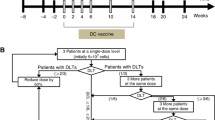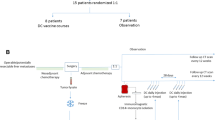Abstract
Mixed bacterial vaccine (MBV) was employed in the multi-modality treatment of hepatocellular carcinoma (HCC) during 1985–1988. Thirty eight patients undergoing palliative resection and cisplatin therapy (Series 1) and 48 patients with unresectable HCC who received hepatic artery ligation + intraarterial cisplatin infusion + radiotherapy (Series 2) were randomized to receive MBV or not. In series 1, the 1- and 2-year survival rates of MBV group and control were 75% vs 58% (P = 0.19) and 45% vs 39% (P = 0.23). In series 2, the 1-, 2- and 3-year survival rates were 59%, 41% and 41% for MBV group and 39%, 25% and 20% for the control, respectively (P 1 = 0.07,P 2 - 0.09, P3 = 0.07). In addition, MBV improved the “second look” resection rate to 40% as compared to 17% in the control (P > 0.05). MBV could also prevent such immunosuppression as decrease of macrophage activity caused by radiotherapy. We consider MBV a potential nonspecific immunostimulant in the multimodality treatment of HCC.
Similar content being viewed by others
References
World Health Organization: Prevention of liver cancer. WHO Technical Report Series No. 691 (1983).
Tang Z Y, Yu Y Q, Zhou X D: The changing role of surgery in the treatment of primary liver cancer.Semin Surg Oncol 2, 103–112 (1986).
Lin Z Y, Tang Z Y: Immunity to subclinical hepatocellular carcinoma, in Tang Z Y (ed):Subclinical hepatocellular carcinoma, pp. 124–142. Springer, Berlin (1985).
Oldham R K: Biologicals and biological response modifiers: Fourth modality of cancer treatment.Cancer Treat Rep 68, 221–232 (1984).
Coley W B: Treatment of inoperable malignant tumors with toxins of erysipelas and the Bacillus prodigiosus.Trans Am Surg Ass 12, 183–212 (1984).
Havas H F, Groesbeck M E, Donnelly A J: Mixed bacterial toxins in the treatment of tumors. I. Methods of preparation and effects on normal and sarcoma 37 bearing mice.Cancer Res 18, 141–148 (1958).
Coley W B: End results in Hodgkin’s disease or lymphosarcoma treated by mixed toxins of erysipelas and Bacillus prodigiosus, alone or combined with radiation.Ann Surg 88, 641–667 (1928).
Nauts H C, Peiner L, Fowler G A: Sarcoma of the soft tissues, other than lymphosarcoma, treated by toxin therapy. End results in 186 determinate cases with microscopic confirmation of diagnosis: 49 operable, 137 inoperable. New York Cancer Research Institute, Monograph No. 3, New York (1959).
Nauts H C, Fowler G A: End results in lymphosarcoma treated by toxin therapy alone or combined with surgery and/or radiation (87 cases) or with concurrent bacterial infection (14 cases). New York Cancer Research Institute, Monograph No.6, New York (1969).
Fowler G A: Beneficial effects of acute bacterial infections or bacterial toxin therapy on cancer of the colon or rectum. New York Cancer Research Institute, Monograph No.10, New York (1969).
Nauts H C: Osteogenic Sarcoma: End results following immunotherapy (bacterial vaccines) 165 cases, or concurrent infections, inflammation or fever, 41 cases. Cancer Research Institute, Monograph No. 15, New York (1975).
Nauts H C: The beneficial effects of bacterial infections on host resistance to cancer: End results in 449 cases. New York Cancer Research Institute, Monograph No.8 (2nd edition), pp. 1–225, New York (1980).
Nauts H C: Bibliography of reports concerning the experimental or clinical use of Coley toxins(Streptococcus pyogenes andSerratia marcescens) 1893–1989. (393 references, inclucling 143 by W B Coley) Cancer Research Institute, New York (1989).
Johnston B J, Norales E T: Clinical effect of Coley’s toxin: II. A sever-year study.Cancer Chemother Rep 21 43–68 (1962).
Miller T R, Nicholson J T: End results in reticulum cell sarcoma of bone treated by bacterial toxin therapy alone or combined with surgery and/or radiotherapy (47 cases) or with concurrent injection (5 cases).Cancer 27, 524–548 (1971).
Nauts H C: Bacterial products in the treatment of cancer: Past, present and future, in Jeljaszewicz J, Pulverer G, Roszkowski W (eds):Bacteria and Cancer, pp. 1–25. Academic Press, London (1982).
Axelrod R S, Havas H F, Murasko D M, Bushnell B, Guan C F: Effect of the mixed bacterial vaccine on the immune response of patients with non-small cell lung cancer and refractory malignances.Cancer 61, 2219–2330 (1988).
Havas H F, Donnelly A J: Mixed bacterial toxins in the treatment of tumors: IV. Response of methylcholanthrene-induced, spontaneous, and transplanted tumors in mice.Cancer Res 21, 17–25 (1961).
Donnelly A J, Havas H F, Groesbeck M F: Mixed bacterial toxins in the treatment of tumors. II. Gross and microscopic changes produced in sarcoma 37 and in mouse tissues.Cancer Res 18: 149–154 (1958).
Tang Z Y, Bao Y M, Chal L M, Ma Z C, Liu K X, Zhao G, Havas F, Nauts H C: Mixed bacterial vaccine augments the response to chemo or radiotherapy in nude mice bearing human hepatocellular carcinoma xenografts (in press).
Herberman R B: Biological response modifiers in the therapy of cancer.Ann Allergy 54, 376–382 (1985).
Askenase P W, Hayden B J, Gershon R K: Augmentation of DTH by doses of CY which do not affect a response.J exp ’ Med 141, 697–702 (1975).
Chandler J J, Stark D B, Allen C V, Fletcher W S: Observation on the treatment of cancer by bacterial toxins.Am Surgeon 31, 443–449 (1965).
Ainsworth E J:The effect of Coley toxins on survival of irradiated mice. Unpublished experiment reported to H C Nauts (1962).
Matsubara S, Suzuki F, Ishida N: Induction of immune interferon in mice treated with a bacterial immunopotentiator, OK-432.Cancer Immunol Immunother 6, 41–45 (1979).
Oshimi K, Kano S, Takaku F, Okumura K: Augmentation of mouse natural killer cell activity by a streptococcal preparation, OK-432.J Natl Cancer Inst 65, 1265–1269 (1980).
Ishii Y, Yamaoka H, Ton K, Kikuchi K: Inhibition of tumor growthin vivo andin vitro by macrophages from rats treated with a streptococcal preparation OK-432.Gann 67, 115–119 (1976).
Carswell E H, Old L J, Kassel R L,et al.: An endotoxin induced serum factor that causes necrosis of tumors.Proc Natn Acad Sci USA 72, 3666–3670 (1975).
Mathe G: Clinical trials of the treatment of minimal residual tumors, In Jin-Pok Kimet al. (eds) Current Status of Cancer Control and Immunobiology. Eui-Hak Moon Hwa Sa, Seoul, Korea, pp. 43–69 (1987).
Old L J, Benacerraf B, Clarke D A,et al.: The role of the reticuloendothelial system in the host reaction to neoplasia.Cancer Res 21, 1281–1300 (1961).
Donovan A J: The effect of surgery on reticuloendothelial function.Arch Surg 94, 247–250 (1967).
Howard J G: Activation of reticuloendothelial cells in the mouse liver by bacterial polysaccharides.J Pathol Bacteriol 78, 465–470 (1959).
Hollcraft J W, Smith W W: Endotoxin treatment and X-irradiation in mice bearing transplanted tumors.J Natl Cancer Inst 21, 311–330 (1958).
Cal L M, Tang Z Y: Experimental treatment of nude rats with human hepatocellular carcinoma with mixed bacterial vaccine.Chin J Immunol 5, 160–161 (1989) (in Chinese).
Author information
Authors and Affiliations
Rights and permissions
About this article
Cite this article
Tang, Z.Y., Zhou, H.Y., Zhao, G. et al. Preliminary result of mixed bacterial vaccine as adjuvant treatment of hepatocellular carcinoma. Med. Oncol. & Tumor Pharmacother. 8, 23–28 (1991). https://doi.org/10.1007/BF02988567
Received:
Accepted:
Issue Date:
DOI: https://doi.org/10.1007/BF02988567




